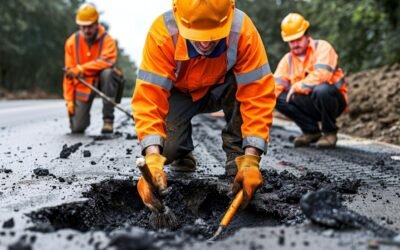A clean, well-maintained parking lot is essential for any business or property owner in Canada. It not only enhances the overall appearance of your property but also ensures the safety and convenience of your customers and visitors. This guide will walk you through the entire process of cleaning and maintaining your parking lot, from understanding Canadian regulations to choosing the right equipment and techniques. By following these steps, you’ll be able to achieve parking lot perfection and make a lasting impression on your visitors. Let’s dive in and explore the ins and outs of parking lot cleaning in the Great White North! 🍁
Table of Contents
Introduction
A well-maintained parking lot plays a crucial role in creating a positive impression for your business or property. It demonstrates attention to detail and care for the safety and comfort of your visitors. Moreover, regular cleaning and maintenance can significantly extend the lifespan of your parking lot, saving you money in the long run. This comprehensive guide aims to help you understand the importance of parking lot cleanliness, Canadian regulations, and best practices for cleaning and maintenance.
Understanding Canadian parking lot regulations
Before starting any cleaning or maintenance project, it’s essential to familiarize yourself with relevant federal and provincial regulations governing parking lot design and upkeep. These rules ensure safety and accessibility for all visitors, including individuals with disabilities.
Federal and provincial guidelines
Federal and provincial guidelines for parking lots vary across Canada. The legal rules of the road apply on parking lots in every other province and territory in Canada, and the road legislation in Alberta and British Columbia applies on privately owned property, including parking lots. Established guidelines for parking lot design, including dimensions, markings, and signage. These guidelines are designed to promote safety and accessibility, and many provinces and municipalities have adopted them as part of their local building codes.
In addition to federal guidelines, provincial regulations may also impact parking lot maintenance. For example, some provinces require property owners to clear snow and ice from parking lots within a specific timeframe to ensure visitor safety. Be sure to consult your local building code and provincial regulations to ensure compliance with all applicable rules.
Accessibility standards
Parking lot accessibility is a crucial aspect of Canadian regulations. Accessibility standards for Canadian parking lots have been in place for many years. The Accessible Canada Act prohibits discrimination and requires that all areas located going to and from designated parking spaces be accessible. Accessible parking spaces must be clearly marked with the international symbol of accessibility and meet specific size and location requirements.
Pre-cleaning assessment and preparation
Before diving into the actual cleaning process, it’s crucial to assess the current state of your parking lot and develop a plan for cleaning and maintenance. This will help you identify problem areas and prioritize tasks to ensure a thorough and efficient cleaning process.
Inspect the parking lot for damage
Start by walking through your parking lot and noting any visible signs of damage, such as cracks, potholes, and faded markings. These issues may require repair or repainting before you begin cleaning to ensure a safe and functional parking area.
Create a cleaning schedule
Develop a cleaning schedule based on your parking lot’s size and usage. High-traffic areas may require more frequent cleaning, while less frequently used areas can be cleaned less often. Consider seasonal
factors as well, such as increased leaf debris in the fall or snow and ice removal in the winter months. A regular cleaning schedule will help keep your parking lot in optimal condition and make it easier to manage long-term maintenance tasks.
Essential equipment for parking lot cleaning
To clean your parking lot effectively, you’ll need a variety of tools and equipment, including:
- Brooms or power sweepers for removing debris
- Pressure washers for cleaning surfaces and removing stains
- Snow and ice removal equipment (if applicable)
- Trash bags and receptacles for collecting litter
- Line striping machines and paint for refreshing parking lot markings
Ensure you have all necessary equipment and supplies on hand before starting the cleaning process to avoid delays or disruptions.
The step-by-step parking lot cleaning process
With proper preparation, you’re ready to tackle the actual cleaning process. Follow these steps to achieve a clean, safe, and visually appealing parking lot:
| Step | Description |
|---|---|
| Clear debris and litter | The first step to cleaning a parking lot is to pick up any trash, sweep away dirt, and remove any other forms of debris. |
| Pressure wash surfaces | Pressure washing is an effective way to remove dirt, grime, and stains from parking lot surfaces. |
| Repair cracks and potholes | Cracks and potholes should be repaired to prevent further damage and improve safety. |
| Refresh parking lot markings | Parking lot stripes should be refreshed to ensure safety and compliance with regulations. |
| Maintain landscaping and lighting | Landscaping should be maintained to enhance the appearance of the parking lot, and lighting should be checked and replaced as needed for safety. |
Clear debris and litter
Begin by removing all visible debris, such as leaves, trash, and dirt from the parking lot surface. Use brooms or power sweepers to efficiently collect and dispose of debris. Be sure to clean around parking stops, curbs, and other hard-to-reach areas.
Pressure wash surfaces
Pressure washing is an effective way to remove dirt, grime, and stains from your parking lot surface. Use a pressure washer with a fan tip to clean the entire area, focusing on high-traffic zones and any visible stains. Be cautious when using a pressure washer around painted lines or markings, as excessive pressure can cause damage.
Repair cracks and potholes
Inspect your parking lot for cracks and potholes, and address any issues promptly. Small cracks can be filled with crack filler, while larger cracks and potholes may require professional repair or repaving. Timely repairs help prevent further damage and ensure a safe, smooth surface for your visitors.
Refresh parking lot markings
Faded or damaged parking lot markings can create confusion and safety hazards. Use a line striping machine and appropriate paint to refresh parking space lines, directional arrows, and other essential markings. Be sure to follow CSA guidelines and local regulations for proper dimensions, colors, and symbols.
Maintain landscaping and lighting
Finally, don’t overlook the importance of well-maintained landscaping and lighting. Trim overgrown vegetation, replace damaged or burned-out lights, and keep the area free of litter and debris. A clean, well-lit, and inviting parking lot will create a positive impression on your visitors and reflect well on your property or business.
Power washing machines
Power washing machines are essential tools for effectively cleaning parking lots. These machines use high-pressure water to remove dirt, debris, and stains from surfaces. They come in various sizes and capacities, ranging from small, portable units to large, truck-mounted systems.
Power washing can significantly improve the appearance of your parking lot, removing grime, oil, and other contaminants. It is also an eco-friendly cleaning method, as it uses water alone or in combination with environmentally-friendly cleaning solutions.
Sweepers and scrubbers
Sweepers and scrubbers are another essential piece of equipment for maintaining parking lots. These machines are designed to remove dust, debris, and dirt from surfaces, making them ideal for both routine cleaning and more extensive deep-cleaning tasks. There are various types of sweepers and scrubbers available, including ride-on, walk-behind, and truck-mounted models.
Sweepers typically use rotating brushes to collect debris, while scrubbers use a combination of brushes and water to clean surfaces. These machines can help maintain a clean and professional appearance for your parking lot and prolong the life of your pavement.
Eco-friendly cleaning solutions
Using eco-friendly cleaning solutions can help reduce the environmental impact of parking lot cleaning. These solutions are biodegradable, non-toxic, and free of harmful chemicals, making them safe for use around people, animals, and plants. Green Earth Environmental Cleaning Solutions Inc. is an eco-friendly partner for parking lot sweeping and pressure washing.
When choosing an eco-friendly cleaning solution, look for products with certifications like Green Seal or EcoLogo, which ensure the product meets stringent environmental and performance standards.
Key Takeaways:
- Power washing machines are essential tools for cleaning parking lots.
- Sweepers and scrubbers are crucial for maintaining parking lot cleanliness.
- Look for products with Green Seal or EcoLogo certifications.
Step-by-step guide to parking lot cleaning
In this section, we’ll walk you through the process of cleaning your parking lot, from clearing debris to power washing surfaces, spot cleaning stubborn stains, and sweeping and scrubbing.
Clearing debris
Before you begin cleaning, it’s essential to clear any debris from the parking lot. Remove litter, leaves, branches, and any other debris that could impede the cleaning process. This step will ensure a more efficient and effective cleaning outcome.
Power washing surfaces
After clearing debris, use a power washing machine to clean the parking lot surfaces. Start at one end of the parking lot and work your way across, systematically cleaning each section. Ensure that you maintain a consistent distance between the power washer’s nozzle and the surface to avoid damage. Always follow the manufacturer’s instructions for your specific power washing machine.
Spot cleaning stubborn stains
After power washing, you may still have some stubborn stains, such as oil or grease spots, that require additional attention. Apply an eco-friendly cleaning solution to these areas and scrub with a stiff-bristle brush to remove the stains. Rinse the area thoroughly with water to ensure all cleaning solution and residue are removed.
Sweeping and scrubbing
Finally, use a sweeper and scrubber to clean any remaining dirt and debris from the parking lot surface. Sweepers will collect debris, while scrubbers will use brushes and water to clean the surface. This final step will ensure a thorough cleaning, leaving your parking lot looking clean and professional.
Key Takeaways:
- Remove all debris from the parking lot before cleaning.
- Use a power washing machine to clean parking lot surfaces.
- Spot clean stubborn stains with an eco-friendly cleaning solution and a stiff-bristle brush.
- Use a sweeper and scrubber to clean remaining dirt and debris.
Regular parking lot maintenance
Regular maintenance is crucial for prolonging the life of your parking lot and ensuring a safe environment for users. This section will cover re-striping and marking, repairing cracks and potholes, and seasonal maintenance considerations.
Re-striping and marking
Over time, parking lot striping and markings can fade due to weather and wear. Regularly inspect your parking lot and re-stripe and re-mark as needed to maintain clear, visible lines and signage. This will help ensure safety and efficient traffic flow in your parking lot.
Repairing cracks and potholes
Cracks and potholes can develop in parking lots due to weather, traffic, and general wear and tear. Regularly inspect your parking lot for damage and make repairs as needed. Addressing these issues promptly can prevent further damage and prolong the life of your pavement.
Seasonal maintenance considerations
Different seasons can present unique challenges for parking lot maintenance. For example, winter may require snow and ice removal, while spring and fall may involve more debris and leaves. Be proactive in addressing seasonal maintenance needs to keep your parking lot in optimal condition throughout the year.
Long-term cost savings through regular maintenance
Investing in regular parking lot maintenance can result in significant long-term cost savings. By addressing issues like faded striping, cracks, and potholes promptly, you can prevent more extensive and costly repairs down the line. Additionally, a well-maintained parking lot can enhance your property’s curb appeal and potentially increase its value.
Regular maintenance also contributes to a safer environment for your visitors, which can reduce the risk of accidents and potential liabilities. Overall, a proactive approach to parking lot care can lead to a more attractive and functional space with reduced long-term costs.
Key Takeaways:
- Regularly inspect your parking lot for faded striping and markings.
- Regularly inspect your parking lot for cracks and potholes.
- Be aware of seasonal maintenance challenges.
- Regular parking lot maintenance can result in long-term cost savings.
Elevating your parking lot to the next level
In this section, we will explore how you can elevate your parking lot to the next level by incorporating landscaping and greenery, improving lighting and safety features, and offering additional amenities for visitors.
Landscaping and greenery
Adding landscaping and greenery to your parking lot can significantly enhance its appearance and create a more inviting atmosphere. Consider incorporating trees, shrubs, and flower beds to soften the hardships and provide natural shade. Be sure to choose low-maintenance, drought-tolerant plants suitable for your local climate, such as native Canadian plants.
Lighting and safety features
Proper lighting is essential for ensuring safety and security in your parking lot. Well-lit areas can help deter criminal activity and reduce the risk of accidents. Consider upgrading to energy-efficient LED lights, which can also save on energy costs. Additionally, you may want to install security cameras and emergency call stations to further enhance safety and security.
Additional amenities for visitors
Providing additional amenities can make your parking lot more user-friendly and appealing to visitors. Consider installing bike racks, benches, and waste receptacles to encourage more sustainable and convenient transportation options. You may also want to offer electric vehicle charging stations to accommodate the growing number of electric vehicles on the road.
Key Takeaways:
- Landscaping and greenery can enhance your parking lot’s appearance and create a more inviting atmosphere.
- Proper lighting is essential for safety and security in your parking lot.
- Offer additional amenities, such as bike racks, benches, waste receptacles, and electric vehicle charging stations.
Achieve Parking Lot Success with Proper Care and Maintenance
Proper care and maintenance are essential for a successful parking lot. By investing in regular cleaning and maintenance, you can prolong the life of your pavement, save on long-term costs, and provide a safe and attractive environment for visitors. Additionally, by elevating your parking lot with landscaping, lighting, safety features, and visitor amenities, you can create a more inviting and functional space that reflects positively on your property or business.
Frequently Asked Questions
How often should I clean my parking lot?
The frequency of cleaning will depend on factors such as traffic, location, and weather conditions. High-traffic areas may require more frequent cleaning, while less busy areas can be cleaned less often. A regular cleaning schedule will help you stay on top of maintenance tasks and keep your parking lot in optimal condition.
Do I need a professional to clean and maintain my parking lot?
While some tasks, such as debris removal and pressure washing, can be completed by property owners or maintenance staff, more complex tasks like crack repair, line striping, and pothole repair may require professional expertise. Assess your parking lot’s needs and your capabilities to determine if hiring a professional is necessary.
What are the environmental considerations when cleaning a parking lot?
When cleaning your parking lot, be mindful of the environmental impact. Use eco-friendly cleaning solutions and avoid using excessive water when pressure washing. Also, ensure that waste, debris, and cleaning runoff are disposed of properly to prevent pollution.
How can I make my parking lot more environmentally friendly?
Consider implementing permeable pavement to reduce stormwater runoff, installing energy-efficient lighting, and incorporating native plants and green spaces into your landscaping. These measures can help reduce your parking lot’s environmental footprint.
How can I improve the safety of my parking lot?
Regular maintenance, including debris removal, crack and pothole repair, and refreshing markings, is essential for parking lot safety. Additionally, ensure proper lighting and signage to help visitors navigate the area easily and safely.
Sources
- TCHIR, JASON. “Do the Rules of the Road Apply in Shopping Centre Parking Lots?” The Globe and Mail, The Globe and Mail, 29 May 2012, www.theglobeandmail.com/globe-drive/culture/commuting/do-the-rules-of-the-road-apply-in-shopping-centre-parking-lots/article4216574/. Accessed 25 Apr. 2023.
- Admin, ADA. “A Guide to ADA Compliance in Canada | ADA Solutions – Tactile Warning Surfaces.” ADA Solutions – Tactile Warning Surfaces | Tactile Warning Surfaces, 11 July 2022, adatile.com/a-guide-to-ada-compliance-in-canada/. Accessed 25 Apr. 2023.
- Green earth ECS. “Green Earth ECS.” Green Earth ECS, 2014, www.greenearthecs.com/. Accessed 25 Apr. 2023.
- “Get Certified or Find Certified Products & Services – Green Seal.” Green Seal, 10 May 2022, greenseal.org/splash/. Accessed 25 Apr. 2023.
- “ECOLOGO Certification.” UL Solutions, 2019, www.ul.com/services/ecologo-certification. Accessed 25 Apr. 2023.









